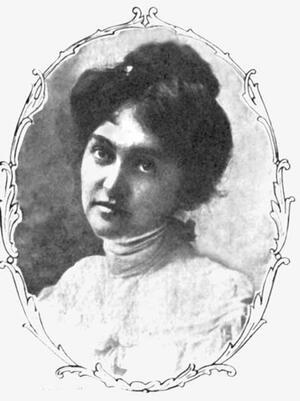Martha Wolfenstein
In her brief career, Martha Wolfenstein was hailed as “the best Jewish sketch writer in America.” From the age of nine until her death, Wolfenstein lived in the Cleveland Jewish Orphan Asylum where her father, a rabbi, served as superintendent. She began not as a writer but a translator, bringing German writer Leopold Kompert’s stories of the Judengasse (Jewish street) to American audiences. In the 1890s she began publishing her own stories of “the Gass,” in both Jewish and mainstream literary journals.. The stories led to her 1901 novel, Idylls of the Gass, which featured strong female characters and a balance between portraying ghetto Jews in a positive light and recognizing the massive cultural shifts underway. After Wolfenstein’s untimely death from tuberculosis, Cleveland’s Martha House for wayward girls was named in her memory.
Article
Heralded as a great literary discovery—compared in her day to Grace Aguilar and Emma Lazarus, hailed by Israel Zangwill and a host of other critics, and described near the end of her life as “the best Jewish sketch writer in America”—Martha Wolfenstein is today a forgotten figure in American Jewish literature.
She was born in Insterburg, Eastern Prussia, Germany, on August 5, 1869, the second child and eldest daughter of Bertha (Brieger) and Rabbi Samuel Wolfenstein. In 1870, her father immigrated to America to assume the pulpit of Congregation B’nai El in St. Louis, Missouri, and a year later the family followed. Martha attended the public schools, first in St. Louis and later in Cleveland, Ohio, where the family moved in 1878 following Rabbi Wolfenstein’s appointment as superintendent of the Cleveland Jewish Orphan Asylum. From age nine until her death, she resided at the orphanage. On her mother’s death, in 1885, she became her father’s housekeeper and confidante; she idolized him.
Wolfenstein studied with her learned father and imbibed his stories of village life in Moravia, where he was raised. Young “Shimmele,” the “wonder-child” in her novel Idyls of the Gass (1901), was modeled upon these stories. Her dedication—“to the original Shimmele, the precious source of all I have accomplished or may accomplish in this life”—is telling.Wolfenstein’s talent as a writer emerged early, but her first published works consisted of translations from German. She was especially influenced by Leopold Kompert’s stories of Jewish life in the Judengasse, the “Jewish Street.” In the 1890s, she published her own stories of Jewish life in “the Gass” both in Jewish newspapers and in general periodicals like Lippincott’s Monthly Magazine. These led to her moving novel Idyls of the Gass, which, like much of her writing, featured a strong and appealing female hero. Maryam, Shimmele’s grandmother, was not only a “smart woman” who could “pasken [answer ritual questions] as well as any rabbi,” she was also modern enough to read “German books with not a word of Yiddishkeit[Judaism] in them.” The novel, as a whole, was unusually sympathetic to ghetto Jews and their highly ethical way of life, even as it was conscious of impending change. It garnered positive reviews, but never achieved the commercial and critical success of Israel Zangwill’s ghetto tales.
Bereft of literary acquaintances, Wolfenstein lacked self-confidence: “I have never yet finished a bit of writing that I was not wholly depressed with,” she admitted in a 1901 letter to Henrietta Szold. Her writing displayed charm, learning, and a distinctive woman’s perspective, but was sentimental and often shallow. Still, contemporaries considered her full of promise, and she achieved more recognition than most American Jewish women writers of her day.
Tragedy struck in 1902 when she was felled by tuberculosis, the disease that had earlier killed her mother and two brothers. She lingered for four years, during which time the Jewish Publication Society published a collection of her short stories, A Renegade and Other Tales (1905). She also wrote a play that remains unpublished. Martha Wolfenstein died, at age thirty-six, on March 17, 1906. Martha House, a home for wayward girls in Cleveland, was named in her memory.
Selected Works
Idyls of the Gass (1901); A Renegade and Other Tales (1905).
AJYB 4 (1902–1903): 208, 218, 226, 310–311; 6 (1904–1905): 208–209; 8 (1906–1907): 225.
Gartner, Lloyd P. History of the Jews of Cleveland. Cleveland: Western Reserve Historical Society, 1978.JE.
“Martha Wolfenstein, Sketch Writer.” Maccabean 10 (1906): 16.
Polster, Gary Edward. Inside Looking Out: The Cleveland Jewish Orphan Asylum, 1868–1924.Kent, Ohio: Kent State University Press, 1990.
Sarna, Jonathan D. JPS: The Americanization of Jewish Culture, 1888–1988. Philadelphia: The Jewish Publication Society, 1989.
UJE.
Wolfenstein, Martha. Letters and papers. AJA, Cincinnati, Ohio, and Jewish Publication Society, Philadelphia Jewish Archives Center.


